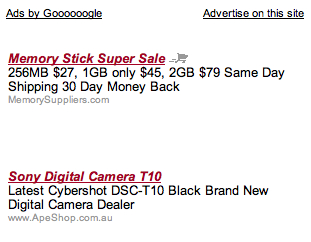Google Cracking Down on MFA Arbitrage
JenSense is reporting that Google is disabling arbitrage publisher accounts as of June 1st. Some publisher are getting emails stating that they have a business model that is not a good fit for AdSense, and their accounts would be disable. The publishers will get to keep any money they make before June 1st.
One thing that is not 100% clear is what exactly determined which accounts got the emails. Reading a thread at Webmaster World, which includes comments from many webmaster who received the email, it is not clear what the exact problem was. Were they banned strictly for doing arbitrage, or was it because it they had MFAs (Made-For-AdSense websites)?
My personal opinion is that Google is cracking down on accounts that have sites which provide a bad user experience. We all know those websites that have very little content and the ads are the only obvious way to leave the site. Kim Malone has already stated that Google does not like these sites. This is from a Search Engine Watch article:
Kim Malone, Director of Online Sales & Operations for Google, gave the generic search engine response. “We’re interested in a positive user experience,” she said. She did share, however, that misleading users is not acceptable. For example, you cannot offer something for sale in a PPC ad and then direct consumers to a landing page full of ads instead.
Google has nothing against arbitrage itself. It is possible to do arbitrage, and still supply a good user experience. I have a site where 25% of my traffic comes from AdWords. Almost all the income from this site is from AdSense. But, I know this is a good user experience because users who get to my site from AdWords spend an average of over 5 minutes at the site reading an average of 10 pages each. All the content is unique and relevant to the ads that I display. Google’s AdWords system also recognizes the quality of the user experience, because most of my keywords rank a “Great” quality score. The quality scores measures the relevance of you page content to the keywords you use for your AdWords ads. This great quality score allows me to keep my bid prices very low. The high page count per user at my site means I don’t need a huge CTR on each page to make a profit. For example, if I pay 5 cents per click on my ads, and I have a page CTR of 3.33%, and my pages per visitor is 10, I only need to make 15 cents per click to break even. Add to that the fact that the user has had a good experience at my site and is likely to come back and recommend it to others, I am way ahead. I don’t think Google would complain about this type of arbitrage.
I think one source of confusion is that many people equate arbitrage and MFAs. This is because almost all MFAs engage in arbitrage, and most arbitrageurs use MFAs site. But, as I have shown above, it is possible to do arbitrage in a way that provides users with a positive experience.
The other question is whether or not this will be good or bad for publishers. There are a few factors at work here.
First, Google’s disabling of many MFA arbitrageurs accounts means there are going to be fewer AdWords advertisers as well. Fewer advertisers means less competition, and lower click prices. That’s bad for publishers.
Next, eliminating MFAs from the AdWords advertising pool and making the user’s experience better means people may be more likely to click on ads in the future. If someone has an experience where they click an ad and are led to a spammy page with more ads, they are less likely to click on ads in the future. That’s good for publishers.
Finally, some advertisers do not use the content network because they do not want their ads to appear on MFAs. Banning MFAs from the system will mean more advertisers are willing to use the content network in the future. That’s good for publishers.
So, I think there may be a slight, initial dip in publishers earning as the MFA arbitrageurs leave, but in long run I think things will even out.
Update: Shoemoney has a video on the subject. He says many big time arbitrageurs have not been kicked out of AdSense.



